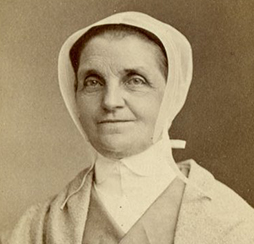
Shaker Pie is Rational: Some Thoughts on Pi Day 2023
Pie unites because it is so divisible. Unlike pi, pie was rational to Shakers who shared fairly at the dining table. How the Canterbury Shakers conceived of themselves was found not in distinctive foods but rather in their communal foodways: soups, meats, and vegetables were dished out from shared platters and bowls. Bread, cake, and pie were sliced as fairly as possible to provide each present at the table with a ration.

Pie—savory or sweet—was the principal dish of a meal for New Englanders, who ate pie for breakfast, dinner (lunch), or supper well into the late nineteenth century. Pie continued its preeminence on the Shaker table into the twentieth century. Sister Ethel Hudson (1896-1992), the last Shaker at Canterbury, succinctly recalled the dining experience In the Dwelling’s dining room: “Pie, and the simultaneous scraping of chairs on the floor.”
Pie was challenged in the mid nineteenth century, when health reformers blamed a whole host of bodily ills on the tasty dish. Catharine Beecher and Sylvester Graham protested the use of what Beecher called the “three evils” in pie “paste”: “animal fat, cooked animal fat, and heavy bread.”
The Canterbury Shakers embraced “Grahamism,” adopting in the 1830s a vegetarian diet. Soon thereafter Shakers were instructed to eschew “swine flesh.” Henry Blinn (1824-1905) recorded that, on August 30, 1848, “no more pork was placed on the table. The Trustees sold what was on hand except that used at the Office for the hired men. The swine were also sold from the pens.” Blinn noted that lard was no longer used in cooking.It’s one thing to go without ham and bacon, produced in the Village’s now-razed Hog House (1817) and Bacon House (1825). It’s quite another to go without lard, a byproduct of hog slaughtering and long an essential ingredient in making pie crust. Butter, too, if the Shakers were strict Grahamites.
This decision must have greatly changed the Village’s kitchen sisters’ work. This deserves more research, but we can see lasting effects of the pork ban (lifted in 1860) in the first published Shaker cookbook, authored by Canterbury Kitchen Deaconess Mary Whitcher (1815-1890) in 1882.
Butter replaced lard in much of the kitchen sisters’ cooking and baking. Milk that was once converted to cheese for sale to the World was, by the 1850s, churned into butter for the community. Whitcher had moved with her family to the Village in 1826, so she experienced this period of heightened debate about food, health, and belief and the changes in diet the Shakers adopted. Sometimes it’s difficult to change back.
And that’s what The Shaker House-Keeper reveals. It includes beef and fish dishes aplenty, but relatively few pork dishes, all of which were boiled, baked, or fried over coals. Other recipes were heavy with milk, butter, and cream. Only nine food recipes mention lard. The pie recipes list no ingredients for or directions to make pie crust. Whitcher, rationally, left the choice of pastry fats to the reader.




